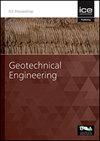Field and laboratory study of compacted filtered iron ore tailings-Portland cement blends for dry stacking purposes
IF 1.7
4区 工程技术
Q3 ENGINEERING, GEOLOGICAL
Proceedings of the Institution of Civil Engineers-Geotechnical Engineering
Pub Date : 2023-09-14
DOI:10.1680/jgeen.23.00097
引用次数: 0
Abstract
The dry stacking of filtered tailings emerges as an alternative to deal with the safety-related problems of conventional slurry disposal in reservoirs behind upstream dams. Incorporating a cementing agent into the tailings before compaction can enhance the overall geomechanical behaviour of these structures, giving rise to more stable and safer stackings. However, few dry stacks are in operation worldwide, and their field performance needs to be better understood. Also, the cement addition provides further challenges to the design of these structures. Thus, obtaining reliable laboratory data for properly designing these tailings storage facilities is essential. Accordingly, this paper evaluates the mechanical behaviour of artificially cemented iron ore tailings for dry stacking purposes, focusing on comparing the responses between on-field compacted samples and laboratory-assembled specimens. For such, the following tests were carried out: ultrasonic pulse velocity, unconfined compression, split tensile, and triaxial compression. Both the stiffness and the strength data could be well-described by the porosity/cement index, and, despite minor differences, there was a good agreement between the responses of laboratory and field compacted samples. These findings highlight the laboratory procedures’ adequacy in reflecting the material's real on-field conditions.干堆用压实过滤铁矿尾矿-硅酸盐水泥混合物的现场和实验室研究
过滤后的尾矿干堆是解决上游坝后水库常规浆体处置安全问题的一种替代方法。在压实前将胶结剂掺入尾矿中可以提高这些结构的整体地质力学性能,从而产生更稳定、更安全的堆垛。然而,在世界范围内,很少有干堆在运行,它们的现场性能需要更好地了解。此外,水泥的添加对这些结构的设计提出了进一步的挑战。因此,获得可靠的实验室数据对于合理设计这些尾矿储存设施至关重要。因此,本文评估了用于干堆目的的人工胶结铁矿尾矿的力学行为,重点比较了现场压实样品和实验室组装样品的响应。为此,进行了以下测试:超声脉冲速度、无侧限压缩、劈裂拉伸和三轴压缩。孔隙度/水泥指数可以很好地描述刚度和强度数据,尽管存在微小差异,但实验室和现场压实样品的响应之间存在很好的一致性。这些发现突出了实验室程序在反映材料的实际现场条件方面的充分性。
本文章由计算机程序翻译,如有差异,请以英文原文为准。
求助全文
约1分钟内获得全文
求助全文
来源期刊
CiteScore
4.40
自引率
4.50%
发文量
68
审稿时长
3 months
期刊介绍:
Geotechnical Engineering provides a forum for the publication of high quality, topical and relevant technical papers covering all aspects of geotechnical research, design, construction and performance. The journal aims to be of interest to those civil, structural or geotechnical engineering practitioners wishing to develop a greater understanding of the influence of geotechnics on the built environment.

 求助内容:
求助内容: 应助结果提醒方式:
应助结果提醒方式:


